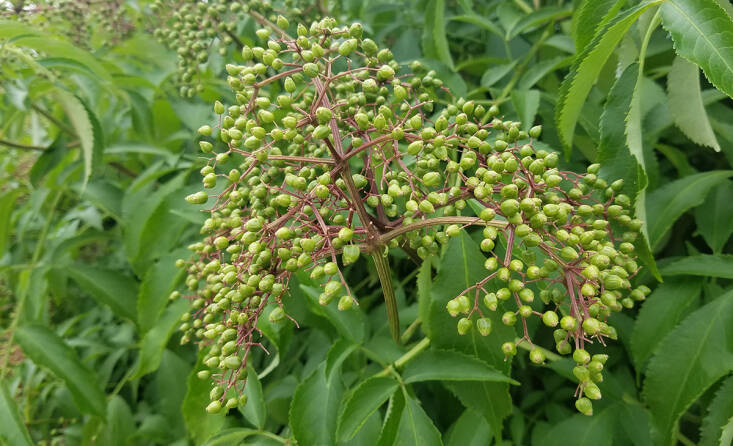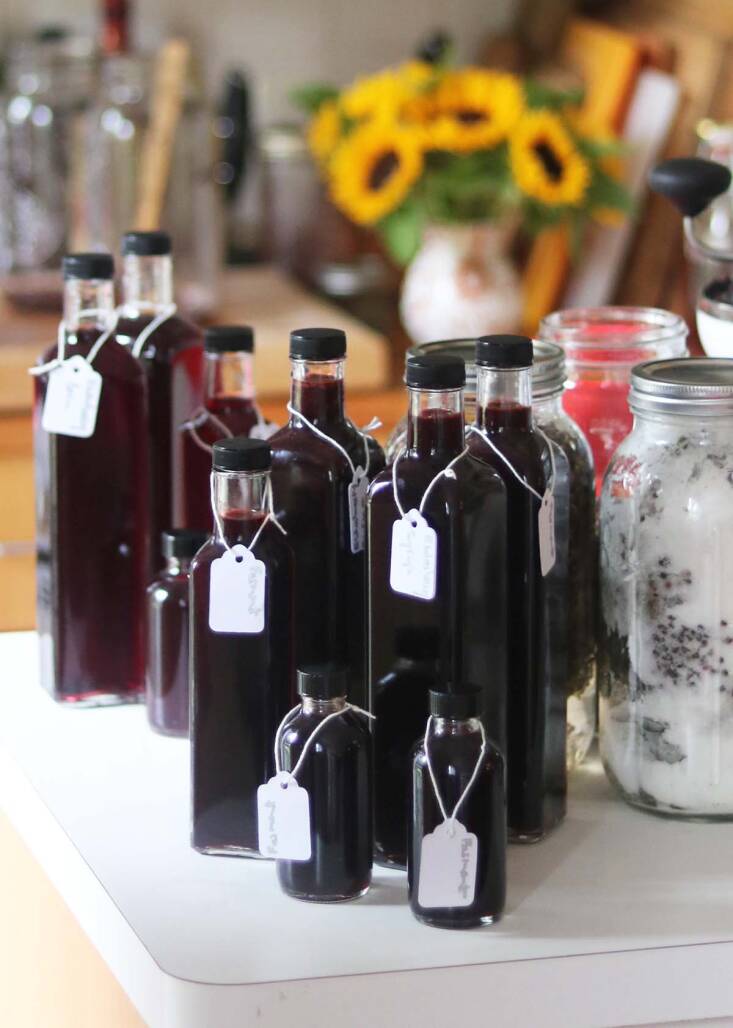Elderberries ripen as summer stretches into cicada days and cricket nights. The fruit is seldom brought to market, so gardeners and foragers must either grow elderberries at home, or collect them from feral shrubs. Both the multi-billion dollar supplement industry and artisanal producers tout elderberry extract as a cure-all. But collecting and making one’s own elderberry syrup from shrubs groaning with fruit is infinitely better tasting, and much more fun. Also cheaper. Elderberries are delicious when prepared correctly (raw, they can be toxic), and the purple syrup is a permanent fixture in my wild-inspired pantry. While I make a cooked syrup, too (which is shelf-stable) the fermented elderberry cordial I prefer has a more complex layering of flavors, as well as the light effervescence that turns every pour into a party. I use elderberry syrup in baking, savory sauces and braises, soups and ketchups. And in uniquely refreshing drinks.
Join me in a summer ritual.
Photos by Marie Viljoen

There are conflicting findings—ever-developing—about whether elderberry has antiviral effects. Small studies have said yes. More recent studies are saying, Well, not so fast. It can be vexing for anyone interested in the facts. But information evolves, and our minds need to remain open. Treat emphatic health claims with caution and with investigative curiosity. Now, rolling with the science-based punches, I use elderberry as an appealing placebo when I sense a sniffle, and more often as a very compelling culinary ingredient.

The elderberries we eat are members of the Sambucus nigra species complex, with subspecies native to North America, as well as named cultivars (sometimes with burgundy, lacy leaves). They are hardy shrubs, and will grow in USDA Hardiness Zones 3–9. Plant your elderberry in full sun or partial shade (more sun means more flowers and more fruit). The medium-sized shrubs prefer moist soil but tolerate a wide range of conditions. Elderberries grow fast so are not ideal for containers unless you root-prune them every year to prevent them becoming rootbound.

Cooking or fermenting elderberries is key to consuming them safely. Raw fruit can be toxic in quantity, even when ripe. And something magical happens with heat as well as with fermentation: The muddy flavor of raw, ripe elderberries is transformed by both processes. Ripe elderberries, fermented for days or weeks, become bright and assertive. (Cooked, they become red-winey and mellow.)

Even unripe green fruit—considered very toxic, raw—is rendered edible by fermentation, as the Nordic Food Lab has demonstrated, but making elderberry capers is another story. Never eat raw green elderberries unless they have been fermented, first.

By the time elderberries are very ripe, their stems snap easily. In good years their umbels are so loaded with juicy drupes that it requires little effort to clip off their clusters and harvest several pounds. To prepare elderberries for fermenting or cooking you need to detach each fruit from its stem. (It takes me about an hour to de-stem five pounds of fruit.) The juice stains like cherry juice, but a soak in cold water followed by an on-the-spot spritz with diluted bleach fixes it. Still, wear an apron.



I have been making sugar-extracted, fermented syrups since I learned the Korean and Japanese techniques for creating complex “juices” and “teas” from ume (Prunus mume) and yuzu (Citrus junos). The gradual extraction yields a liquid far more aromatic and nuanced than a boiled syrup would. You can apply this technique to any fruit.
Fermented Elderberry Syrup
(Adapted from Forage, Harvest, Feast – A Wild-Inspired Cuisine)
Makes about 3 cups (750 ml)
The transformative process of fermentation converts elderberries into something darkly appealing, with a tart backbone and a crisp sweetness. The intense syrup is a concentrate, meant to be used in Aristotle’s holy moderation. You are not chugging it all at once. Diluted with sparkling water, or mixed with other ingredients for an aperitif, the syrup has a refreshingly complex flavor.
Keep the bottles in the refrigerator: Continuing fermentation could cause CO2 to build up to create a potential bottle bomb.
- 1¼ pounds (about 4 cups) ripe elderberries
- 1 ¼ pounds (566 g) sugar
Place the fruit in a clean jar and cover with the sugar. Close the lid and shake the jar until the fruit and sugar are well mixed. Loosen the lid or cover the jar’s mouth with cheesecloth secured with string or a rubber band. The fruit will begin to ferment after a few days and you will notice the syrup level beginning to rise. Shake or stir occasionally. I usually leave my syrup out for about 20 to 30 days, until I like the flavor. Strain the syrup through a double mesh sieve and then again through double cheesecloth. Siphon it into sterilized bottles and keep in the refrigerator for peace of mind.
Use the leftovers: Cover the pomace (strained fruit) with gin and strain after a week for a very purple-hued gin-infusion. Or, if you don’t drink alcohol, store the strained fruit in a jar and keep in the fridge for adding to cooked dishes or bakes.


Bug Slayer
Whether or not elderberry actually slays bugs, it tastes very good, going down. Just remember to hydrate!
- 3 oz Elderberry gin
- 1 oz Elderberry syrup
- 1 oz fresh lemon juice
Combine in a shaker with ice cubes. Shake well. Strain and pour, garnishing with your favorite edible flowers.
For more of Marie’s recipes, see:
- Green Fig Preserve Recipe: A Taste of South Africa
- How to Eat Passionfruit (Let Us Count the Ways)
- The Truth About an Indoor Lemon Tree (Hint: It Belongs Outdoors)












Have a Question or Comment About This Post?
Join the conversation (0)